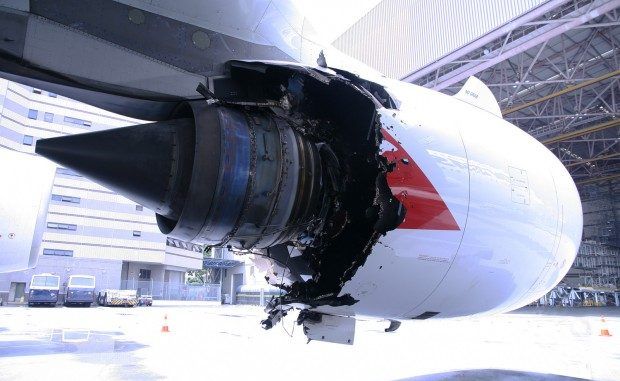
What is going on with the Airbus A380 Commercial airliner? The world’s biggest passenger plane has suffered a series of at least 7 emergency landings since it was launched in 2010 to global critical praise.
When this 600 ton monster was introduced 3 years ago, sceptics expressed fears about its size and the impact it would have on already-overstretched airport facilities. Engineers questioned the logic of it being so big that it was not able to fill its wing fuel tanks to capacity because of weight. Then, almost immediately after it entered service, one almost crashed,
Qantas Flight 32 was a Qantas scheduled passenger A380 flight which suffered an uncontained engine failure on 4 November 2010 and made an emergency landing at Singapore Changi Airport. The failure was the first of its kind for the Airbus A380, the world’s largest passenger aircraft. It marked the first aviation occurrence involving an Airbus A380.

BYPASS THE CENSORS
Sign up to get unfiltered news delivered straight to your inbox.
You can unsubscribe any time. By subscribing you agree to our Terms of Use
The official explanation ran something like this – on inspection it was found that a turbine disc in the aircraft’s No.2 Rolls-Royce Trent 900 engine (on the port side nearest the fuselage) had disintegrated. The aircraft had also suffered damage to the nacelle, wing, fuel system, landing gear, flight controls, the controls for engine No.1 and an undetected fire in the left inner wing fuel tank that eventually self-extinguished.
The failure was determined to have been caused by the breaking of a stub oil pipe designed to lubricate one of the engine main axles or shafts. The pipe, the size of a child’s thumb and forefinger, overheated, became blocked and stopped working. The engine then overheated in turn and blew up as a result.
But the actual story of what happened after the engine detonated ran more like this – Qantas 32 was presented as a minor engine failure. They actually lost all three hydraulics systems, the flaps, undercarriage and engine power control on the engine which exploded, one engine then went to full power and stuck and the remaining two would only go to 60%. They were losing fuel because the engine fan blade which severed the hydraulics also went through the left wing fuel tank. Fuel gushed out of the rip in the wing which could have caught fire at any time. It was still pouring out when the plane touched down.
They steered the plane down using the throttles because that was all they could still control and, luckily for them and the passengers, they had an extra check captain and a check check captain reviewing the crew making five highly-experienced flight crew on board to assist. They landed at very high speed with a heavy fuel load and almost no hydraulic control. Minus brakes, they eventually stopped a very dramatic 100 m short of the end of the 4,000 metre runway.
After the incident, Qantas grounded its entire multi-billion dollar fleet of A380s while Airbus Industrie and Rolls-Royce engineers, makers of the new super-powerful Trent 900 engine, performed a post-mortem.
We have identified at least a further seven emergencies of different types since this incident in 2010. The A380 is undoubtedly a big, beautiful concept. Passengers and crew love it. But a series of incidents which have mostly not exactly hit the headlines have occurred since the Superjumbo took to the skies.
An Emirates flight from Sydney to Dubai made an emergency landing shortly after takeoff because of an engine fault on November 12, 2012.
October 23 2011 a Dubai-bound Emirates flight from Bangkok was forced into landing under emergency conditions at Hyderabad’s Rajiv Gandhi International Airport in India following “technical problems”.
A Lufthansa Airbus A380 Superjumbo suffered a hydraulic problem on approach to Frankfurt and forced the airliner to make an emergency landing on August 7, 2012. The nose wheel failed to lock in the down position and the pilot had to make a very cautious touchdown under full emergency conditions. The landing gear mercifully held up and there was no damage or injury.
Then on January 6, 2014 an Airbus A380 operated by Singapore Airlines was forced to make an emergency landing in Azerbaijan due to loss of cabin pressure.
The plane was flying from London to Singapore and had 467 passengers and 27 crew members on board. The airline said that oxygen masks were deployed and the aircraft landed “uneventfully” at the Baku airport.
On December 7, 2014 a Qantas A380 was forced to abandon its path when its cabin lost air pressure. The QF2 flight reportedly dropped from 39,000 feet to 9,000 feet in just minutes on its way from Dubai to Sydney and was forced to land at Perth airport instead.
The list goes on. It’s not unheard of for planes, which fly millions of miles safely every year, to encounter the occasional problem. But the frequency of reports of cabin depressurisation, landing gear issues and engine failures on the new Airbus A380 are far more frequent than they should be.
Watch a video of the Qantas 32 fuel leak here.

